教科版高中英语必修一全册备课教案(教学设计)
高中英语必修1教案

高中英语必修1教案一、教学目标1.了解英语的基本语法和词汇;2.掌握英语的基本语音、语调和语音规则;3.能够听、说、读、写基本的英语句子;4.能够理解简单的英语文章;5.培养学生的英语学习兴趣和自信心。
二、教学内容1. Unit 1 Friendship1.词汇:friend, friendship, honest, loyal, trust, etc.2.语法:be动词的用法、形容词的比较级和最高级、名词的单复数等。
3.阅读:阅读有关友谊的文章,理解文章中的主要内容和细节。
4.写作:写一篇关于友谊的短文。
2. Unit 2 English around the world1.词汇:English, language, dialect, accent, etc.2.语法:一般现在时、一般过去时、现在进行时等。
3.阅读:阅读有关英语在世界各地的使用情况的文章,理解文章中的主要内容和细节。
4.写作:写一篇有关英语在自己国家的使用情况的短文。
3. Unit 3 Travel journal1.词汇:travel, journey, adventure, experience, etc.2.语法:现在完成时、过去进行时、过去完成时等。
3.阅读:阅读有关旅行的文章,理解文章中的主要内容和细节。
4.写作:写一篇有关自己的旅行经历的短文。
4. Unit 4 Music1.词汇:music, musician, instrument, melody, etc.2.语法:现在完成进行时、虚拟语气等。
3.阅读:阅读有关音乐的文章,理解文章中的主要内容和细节。
4.写作:写一篇有关自己喜欢的音乐的短文。
三、教学方法1.任务型教学法:通过任务的设置,让学生在完成任务的过程中学习英语知识和技能。
2.合作学习法:通过小组合作学习,让学生在互相帮助和交流中学习英语。
3.情境教学法:通过情境的设置,让学生在真实的语言环境中学习英语。
高一英语必修一教案

高一英语必修一教案通过学习这篇课文,使学生感悟到科学家的周密观察、勇于探索、认真分析的科学精神,使学生了解到科学发现的全过程具有其科学的严密性。
该课文出现了英语重要语法知识--过去分词的用法。
一起看看高一英语必修一教案!欢迎查阅!英语必修一教案1一、说教材1、材的地位和内容该课文John Snow Defeats King Cholera 是人教版高中英语必修5第一单元的一篇文章,这是一篇阅读课。
文章介绍了有名医生John Snow 是如何通过考察、分析和探究的科学方法,发现并控制“霍乱”这种传染疾病的。
通过学习这篇课文,使学生感悟到科学家的周密观察、勇于探索、认真分析的科学精神,使学生了解到科学发现的全过程具有其科学的严密性。
该课文出现了英语重要语法知识--过去分词的用法。
2、教学目标根据该教材的特点以及高中英语课程标准,我拟定下列教学目标1) 语言知识目标词汇:defeat attend expose cure outbreak control absorb severe valuable strict pump 等语法:过去分词作定语和表语2) 语言技能目标练习并培养学生的听、说、读和写的能力,侧重培养和提高学生的阅读理解能力3) 情感目标培养学生的科学探索精神,培养学生科学人文精神相融合的素养4) 学习策略目标学生通过阅读理解、互动交流以及完成任务过程中进行有效地自我调控,通过各种途径获取相关信息,并运用有效教学资源5) 文化意识目标3、学重点和难点重点:理解所读课文;把握过去分词的用法难点:利用所学词汇、句型,围绕主题进行叙述二、说教法根据高中英语课程标准,根据“整体语言教学”的理论和实践,以及当前教学改革的新理念,为达成上述的教学目标,运用“任务型”英语教学法。
在实际的教学活动中,充分体现教师在教学活动中的主导、组织和监控的作用。
充分发挥学生在教学活动中的主观能动性。
以学生为中心,开展自主性学习活动,促使学生通过探究、独立思考以及合作学习的方式,完成学习任务。
高一英语全英教案5篇

高一英语全英教案5篇高一英语全英教案篇1教学目标1. 语言知识目标:1) 能掌握以下单词:rules, arrive, late, hall, dinning hall, listen, listen to, fight, sorry2) 能掌握以下句型:①Don't eat in class.②You must be on time.③Eat in the dining hall.2. 学会用英语表达一些标志的含义。
3. 熟练使用目标语言谈论对某些规章制度(校规、家规等)的看法3. 情感态度价值观目标:能用英语表达和制定一些简单的规则,理解没有规矩不成方圆;无论是在学校时还是在家庭中以及以后走上社会都应当遵守规则,按规则办事。
教学重难点1. 教学重点:1) 肯定祈使句是省略掉主语的原形动词开头;2) 否定祈使句则是在肯定祈使句前加上“don’t”。
3) 情态动词must及have to在用法上的区别。
2. 教学难点:掌握祈使句的用法,并能听懂、会说一些简单的祈使句。
多媒体教学过程Ⅰ. Warming-up and revision教师进教室后,使用祈使句请学生们完成一系列动作:Please stand up/ sit down. Close the door, please. Look at me and listen to me.Don’t open your books. Don’t talk. Let’s begin our class.学生听教师的指令完成各种动作,教师也可将指令写到黑板上,让学生从视觉上考察祈使句的特点。
Ⅱ. Presentation教师出示书上1a 的图片,向学生提问。
指着图上奔跑的男孩提问T:What’s the boy doing? S: He’s running.T: Where is he running? S: He’s running in the hallways.(板书,教读)T:Can you run in the hallways? S: No, I can’t.T: So please don’t run in the hallways.(板书,教读)(= You can’t run in the hallways.)学生跟读数遍,明白祈使句和“can”的表达含意。
新课标高一英语必修一全册教案
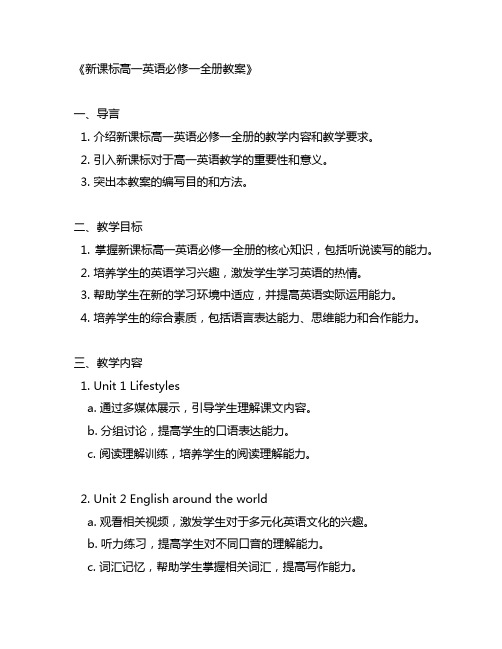
《新课标高一英语必修一全册教案》一、导言1. 介绍新课标高一英语必修一全册的教学内容和教学要求。
2. 引入新课标对于高一英语教学的重要性和意义。
3. 突出本教案的编写目的和方法。
二、教学目标1. 掌握新课标高一英语必修一全册的核心知识,包括听说读写的能力。
2. 培养学生的英语学习兴趣,激发学生学习英语的热情。
3. 帮助学生在新的学习环境中适应,并提高英语实际运用能力。
4. 培养学生的综合素质,包括语言表达能力、思维能力和合作能力。
三、教学内容1. Unit 1 Lifestylesa. 通过多媒体展示,引导学生理解课文内容。
b. 分组讨论,提高学生的口语表达能力。
c. 阅读理解训练,培养学生的阅读理解能力。
2. Unit 2 English around the worlda. 观看相关视频,激发学生对于多元化英语文化的兴趣。
b. 听力练习,提高学生对不同口音的理解能力。
c. 词汇记忆,帮助学生掌握相关词汇,提高写作能力。
3. Unit 3 Travel journala. 语法练习,巩固学生的语法知识。
b. 听力训练,提高学生的听力理解能力。
4. Unit 4 Wildlife protectiona. 观看相关纪录片,引导学生对于野生动物保护问题的思考。
b. 语言实践,激发学生表达观点的能力。
c. 课外阅读,拓展学生知识面,提高综合素质。
5. Unit 5 First aida. 观看教学视频,学习急救知识和技能。
b. 分角色扮演,培养学生的合作意识和团队精神。
c. 讨论交流,引导学生学会在紧急情况下正确表达和沟通。
6. Unit 6 Languagea. 语言点讲解,帮助学生理解和掌握语言的规则与用法。
b. 语言实践,激发学生运用所学语言进行交流。
7. Unit 7 The world of worka. 制定职业规划,帮助学生了解不同职业的本质和发展前景。
b. 个人陈述,提高学生的自我表达能力。
新课标高中英语1必修全册教案

新课标高中英语1必修全册教案一、教学内容1. Unit 1 My First Day at Senior High详细内容:描述了学生在高中的第一天,通过对话和阅读了解校园生活。
2. Unit 2 My New Teachers详细内容:介绍了几位不同风格的老师,学习如何描述人物特点。
二、教学目标1. 掌握本单元的重点词汇和短语,并能灵活运用到实际情景中。
2. 提高学生的听说读写能力,尤其是描述人物和事件的能力。
3. 培养学生学会尊重和理解不同的教学风格,增强团队合作意识。
三、教学难点与重点1. 教学难点:描述人物特点的词汇和句型,以及如何运用到实际情景中。
2. 教学重点:听说读写技能的培养,尤其是口语表达能力的提高。
四、教具与学具准备1. 教具:多媒体设备、PPT、黑板、录音机、卡片等。
2. 学具:课本、练习本、字典、笔等。
五、教学过程1. 导入:通过展示一组学生在高中第一天的照片,引发学生讨论,导入新课。
2. 新课内容展示:讲解Unit 1 My First Day at Senior High 的重点词汇和句型,进行角色扮演活动。
3. 例题讲解:针对Unit 2 My New Teachers,讲解如何描述人物特点,给出示例。
4. 随堂练习:让学生运用所学知识,描述自己的老师,进行小组讨论。
5. 口语练习:模拟情景,让学生进行对话练习,提高口语表达能力。
六、板书设计1. Unit 1 My First Day at Senior High重点词汇:nervous, excited, confused, helpful, friendly等。
重点句型:I felt when; The teacher is and he/she等。
2. Unit 2 My New Teachers描述人物特点的词汇:strict, patient, humorous, knowledgeable等。
描述人物特点的句型:My teacher is; He/She always等。
高中英语必修一备课教案模板

一、教学目标1. 知识目标:掌握本单元的基本词汇和句型,了解相关背景知识。
2. 能力目标:提高学生的听、说、读、写能力,培养学生运用英语进行交流的能力。
3. 情感目标:激发学生对英语学习的兴趣,培养良好的学习习惯。
二、教学内容1. 单元主题:围绕本单元主题展开,如日常生活、文化习俗、科技发展等。
2. 课文内容:选取与主题相关的课文,进行详细讲解和分析。
3. 词汇和句型:总结本单元重点词汇和句型,进行讲解和练习。
4. 阅读理解:选取与主题相关的阅读材料,提高学生的阅读理解能力。
5. 写作训练:进行写作训练,提高学生的写作水平。
三、教学重难点1. 重点:本单元的核心词汇和句型,课文内容的理解,阅读理解的技巧。
2. 难点:学生的发音、语法、词汇运用等方面的问题。
四、教学准备1. 教学材料:教材、辅助教学课件、相关阅读材料、写作练习等。
2. 教学工具:多媒体设备、黑板、粉笔等。
五、教学过程1. 导入- 结合生活实例,导入本单元主题,激发学生的学习兴趣。
- 简要介绍本单元的学习目标和要求。
2. 课文讲解- 分析课文结构,讲解课文内容,帮助学生理解课文。
- 介绍课文背景知识,拓宽学生的视野。
3. 词汇和句型讲解- 总结本单元重点词汇和句型,进行讲解和练习。
- 通过游戏、活动等形式,帮助学生掌握词汇和句型。
4. 阅读理解训练- 选取与主题相关的阅读材料,提高学生的阅读理解能力。
- 分析阅读材料,讲解阅读技巧,引导学生掌握阅读方法。
5. 写作训练- 进行写作训练,提高学生的写作水平。
- 指导学生进行写作,纠正写作中的错误。
6. 总结与反思- 总结本节课的学习内容,回顾重点知识。
- 引导学生进行自我反思,发现问题并改进。
六、教学评价1. 课堂表现:观察学生的课堂参与度、发言积极性等。
2. 作业完成情况:检查学生的作业,了解学生对知识的掌握程度。
3. 考试成绩:通过考试评估学生的学习成果。
七、课后作业1. 复习本节课所学内容,巩固所学知识。
高中英语必修一教案

高中英语必修一教案Unit 1 Friendship类别课程标准要求掌握的项目话题Friends and friendship; interpersonal relationships词汇add point upset ignore calm concern loose cheat reason list share feeling Netherlands German outdoors crazy nature purpose dare thunder entirely power according trust indoors suffer teenager advice questionnaire quiz situation editor communicate habitadd up calm down have got to be concerned about walk the dog go through hide away set down a series of on purposein order to face to face according to get along with fall in lovejoin in功能态度(attitudes)Are you afraid that---?I’ve grown so crazy about---I didn’t dare---2. 同意和不同意(agreement and disagreement)I agree. I think so. Exactly.I don’t agree. I don’t think so. I’m afraid not.3.肯定程度(certainty)That’s correct. Of course not.语法直接引语和间接引语(1): 陈述句和疑问句陈述句“I don’t want to set down a series of facts in a diary.” Said Anne.-----Anne said that she didn’t want to set down a series of facts in a diary.一般疑问句He asked, “Are you leaving tonight?”---He asked us whether we were leaving that night.特殊疑问句“When did you go to bed last night?” father said to Anne.--- Father asked Anne when she went to bed the night before.1.Suggested teaching notes1). Analyses of the teaching contentsThis unit is about friendship, and nearly all the teaching materials center on it. Warming up---The questionnaire leads students to think and talk aboutfriendship, get to know the problems between friendsand seek solutions, which makes preparations for thefurther teaching in topics, background and vocabulary.Pre-reading---The questions prompt students to think critically aboutfriends and friendship in reality, alerting them to the factthat besides people, a diary can be a friend, too.Reading--- The diary by the Jewish girl Anne gave a glimpse of her lifeduring her family’s shelter in Amsterdam from the GermanNazis’ killing in world war 2. she treats the diary as her best friend, and init reveals her longing for a normal life and close contact with nature,which helps her get through the days.Comprehending---It helps students further understand the text by doingmultiple choices, questions and answers, andmatching.Learning about language---It teaches the important expressions andstructures and grammar: direct and indirectspeeches.Using language---The two letters, listening, questionnaire design, letterwriting and fun writing prepares students to furthertalk about friendship, especially the problems withmisunderstanding, and unfriendliness, thusstrengthening students’ abilities to practicelanguage, discover, and solve problems.Summing up---It summarizes the whole contents of this unit from theaspects of topics, vocabulary and grammar.Learning tip--- This part encourages students to form the habit of writinga diary.Integrating skills--- The text introduces the way Hawaiians expressfriendship, to get students to realize the culturaldifferences in the values of friendship in additionits importance in all cultures.2) Making of the teaching planThis unit centers on friends and friendship, exploring different types of friendshipwith particular attention to that one can develop with oneself, i.e., the comfort and support one seeks from an imaginary friend. Students are expected to come to be truly aware of the qualities and conducts that make a good friend, display and develop the ability to cope with misunderstanding, conflicts and problems related to friendship, and give advice on it. The concept that even an ordinary thing can be a friend should break down the traditional belief in the interpersonal nature of friendship. Also, the comparison of similarities dissimilarities in friendship comprehension between the East and the West leads students to know better the values of friendship in Westerns’ eyes. All in all, this unit promises to unveil the true essence of friendship and helps students to lead a more friendly and harmonious life. Thus, based on the theme, contents and teaching objectives, the whole teaching procedures can fall into five3. Teaching plans for each periodPeriod 1 Warming-up and Speaking1. Teaching objectives:1) Target languageI (don’t) think…… I (don’t) think so. I (don’t) agree.I believe…… That’s correct. In my opinion, ……2) Ability goalsa.Describe your friends in Englishb.Figure out the problems between friends and then find different ways to solve theproblems.3)Learning ability goalsa.To encourage students to think and talk about friends and friendship by using somephrases and structures.b.To learn to solve problems that may occur between friends.c. To cultivate the students to form the good habit of learning English in SeniorMiddle School.2. Teaching important points:e the given adjectives and sentence structures to describe one of yourfriends.b.Learn to evaluate friends and friendship.3. Teaching difficult points:a.Work together with partners and describe one of your good friends.b.Discuss with partners and find out ways to solve the problems.4. Teaching methodsa.Task-based teaching and learningb.Cooperative learningc.Discussion5. Teaching aids:CAI6. Teaching procedures and ways:Step 1 Lead-in and Warming-upBefore the lesson, the teacher can arouse the students’ interests by showing a video of Auld Lang Syne .At the beginning of the first class, we can get the students to talk about their summer holidays. The students can talk freely as they like.1.How did you spend your summer holidays? How did you feel? What didyou do in your summer holidays? What did you do in your spare time?2.What do you think of our new school? Do you like it? Could you saysomething about it?3.Do you like making friends? How do get in touch with your friends? Doyou have many friends? Where are they now? Do you have any oldfriends in our school? Have you made any new friends in our class? Step 2 Think it over1. Give a brief description of one of your friends. The following phrases andstructures may be helpful:His/Her name is ……He /She is …… years old.He /She likes …… and dislikes ……He /She enjoys …… and hates……He /She is very kind/friendly/……When /Where we got to know each other.2. What types of friendship do you have? Please tick them out. Then fill in theblanks.girl friends boy friends pen friendslong -distance friends friends of the same agee-friends (friends over the internet) friends across generationsunusual friends like animals, books……1).______ is /are most important to you.2). You spend most of your free time with ____.3). You will share your secrets with _____.4). When in trouble, you will first turn to _____.Step 3 Make a survey1. List some qualities of a good friend or your ideal friend. Have the students get into groups of four to find out what each has listed.Tell your partner your standards of good friends by using the following structure:I think a good friend should (not) be……In my opinion, a good friend is someone who……1.Have a member of each group report on what their lists have in common and listthem on the board.2.Ask the class whether or not they agree with all the qualities listed.3.Then have the students do the survey in the textbook.4.Have the students score their survey according to the scoring sheet on page 8.5.The teacher ask some students how many points they got for the survey and assesstheir values of friendship:Step 4 Talking and sharing( work in pairs)1. If your best friend does something wrong, what will you do?Try to use the following phrases:I (don’t) think…… I (don’t) think so.I (don’t) agree. I believe……That’s correct. In my opinion, ……2. What is a friend?A British newspaper once offered a prize for the best definition(定义) of a friend. Ifyou were the editor, choose the best one from the following entries(条目), and explain why.One who understands my silence.A friend in need is a friend indeed.Friends are just the people who share your happiness and sorrow. When you look at your watch at 4 am, but still know you can call them and wake them up, and they’ll still want to talk to you ,that’s friendship. To have a friend, you need to be a good friend.Step 5 Group work (output)The teacher can give each group one of these questions below to talk about. Then let the class share their ideas. It’s better to stimulate the students to express their own opinions about these questions.1.Do you think it is a good idea to borrow money from your friend?Why and Why not?2. What factors may cause the breakdown of a good friendship?3. What can be your unusual friend besides human beings? And why?Step 6 Homework1.Write down a short passage about your ideas /the factors/your unusual friends.2.Prepare for the new lesson.Period 2 Reading “Anne’s Best Friend”1. Teaching objectives:1) To develop the students’ reading ability, learn to use some reading strategies suchas guessing, key sentences, skimming and so on;2). To get the students to realize the importance of friends and friendship, and to telltrue friends from false friends;3). To grasp some useful words and expressions in this passage, such as on purpose,be crazy about etc.;4). To learn the writing style of this passage.2. Teaching method: Task-based teaching3). Teaching procedure:Step 1.Pre-reading1. Please enjoy three pieces of music and find out what they are about.2 .Why do you think friends are important to you?3. What do you think a good friend should be like? List the good qualities a goodfriend should have .4. Have you ever considered making friends with animals, plants or even an object?Why or why not?Step 2.Reading1. Try to guess what Anne’s friend is and what the passage is about by reading thetitle and having a quick at the pictures in this passage without reading it.2. Skimming the first two paragraphs to confirm your guessing.1) What was Anne’s best friend? Why did she make friends with it?2) Did she have any other true friends then? Why?3) What is the difference between Anne’s diary and those of most people?4) Do you keep a diary? What do you think most people set down in their diaries?5) We are going to read one of Anne’s diaries .but before reading ,can you tell me what the diary is about with the help of one key sentence in the 2nd paragraph?3. Reading of Anne’s diaryHow she felt in the hiding placeTwo examples to show her feelings thenStep 3.Post-reading1.What would you miss most if you went into hiding like Anne and her family?Give your reasons.2.Group workWork in groups to decide what you would do if your family were going to be killed just because they did something the Emperor did not like.Where would you plan to hide?How would you arrange to get food given to you every day?What would you do to pass the time?------3. Discovering useful words and expressionsStep 4.Talking about friends and friendship1.There are many proverbs about friends and friendship. Choose the one you agreewith and explain why, then choose one you disagree with and explain why.2. We have talked about friends and friendship today, can you write one or twosentences to express your understanding of friends and friendship.Step 5.Homework:1. Interview a high school student, a businessman, a police officer and a housewifeto find out their opinions about friends and friendship. Write a report to share it with the whole class.2. Describe one of your best friends following the writing style of this passage. Ending: Let’s sing this song about friends togetherPeriod 3 Grammar1.Teaching objectivesLearn to use direct speech and indirect speech2. Teaching important pointSummarize the rules of Direct Speech and Indirect Speech.3. Teaching difficult pointLearn about the special cases in which the tenses shouldn’t be changed.4. Teaching methodsDiscussing, summarizing and practicing.5.Teaching proceduresStep1 Lead inT: In the last lesson, we learned Anne Frank’s story. She is telling her stories to two of her friends—you and Tom. Tom has something wrong with his ears, so you have to repeat Anne’s sentences, using indirect speech. Sometimes you explain Tom’s sentences to Anne.“I have to stay in the hiding place.” said Anne. →Anne said she had to stay in the hiding place.“Do you feel sad when you are not able to go outdoors?” Tom asked Anne. →Tom asked Anne if/whether she felt sad when she was not able to go outdoors.“I don’t want to set down a series of facts in a diary,” said Anne.→Anne said that she didn’t want to set down a series of facts in a diary.“What do you call your diary?” Tom asked. →Tom asked what she called her diary.Ss go on this topic by themselves.Step2 GrammarT: Now let’s look at these sentences again. If we want to change Direct Speech into Indirect Speech, what should be changed?Ss discuss by themselves.Ss: sentence structures, tenses, pronouns, adverbials of time and place and verbs should be changed.T: Quite right. Look at the form on the screen. These are the rules...Step3 practice1.T: Turn to Page 5. Please change the following direct speech into indirect speechand indirect into direct...Step4 Correcting mistakesT analyses the common mistakes Ss have made during the practice.T: Now let’s look at the screen and pay attention to these sentences. Choose the right sentence and tell me why the other one is wrong.Step5 A gamePlay a guessing game “who is my secret friend?” One student comes to the front with his partner.The rest students ask him questions while his partner changes them into indirect speech. In the end, the person who has guessed the right answer can come to the front to take the place of the first student .So the game goes on.Suggested sentences:Can your friend speak?What does he/she wear today?Is he/she tall or short?What do you and your friend do in your free time?Do you quarrel with each other?...Step6 HomeworkDo Exercise1 on Page 42. Here is another page of Anne’s diary. Read it through and then use indirect speech to retell the story.Period 4 Integrating skills“Friendship in Hawaii”1. Teaching objectives:To learn about ways of showing friendship in Hawaii and share their opinions on friendship. Because it is a lesson of integrating skills, Ss are also asked to write sentences on friendship.2. Teaching procedures:Step1 Lead-in1. Talk about different ways of showing friendship of minority groups in China.2. Compare Chinese ways of showing friendship with Western ways. And discusswhy there is a big difference. Therefore, show the sentence: Every culture has its own ways to show friendship.3. Ask students if they can think of any place in the world where Chinese andWestern cultures live side by side. They may think of Hongkong, Macao, Singapore.And the teacher will add one more -------Hawaii.Step2 Fast reading1. It is said that Hawaii is a place where the East truly meets the west. Consider howpeople show their friendship in Hawaii.Show a picture and find the information from the textbook. ( by giving “leis” to one another.)Explain what is a “lei”.2. Read fast and find out more ways to show friendship in Hawaii to fill in the form.3. According to the form, ask them to consider what friendship is in Hawaiians. Step 3 Careful reading1.Read the 2nd paragraph carefully and ask “Why do many different peoples callHawaii their home?”( Hawaii is a place where people make one big community from many smaller communities. It means Hawaii has a rich cultural diversity.)Step 4 Writing task1.Show proverbs about friends and friendship. Explain them and ask Ss to choosesome they agree with and some they disagree with and explain why.2.Discuss with their partner and try to write some similar sentences to show theiropinions on friendship.Step 5 HomeworkSurf the Internet to collect materials like poems, stories about friendship. And share them with your friends.Period 5 Listening & Writing1. Teaching objectivesTo practise students’ listening ability.To practise students’ writing skills of how to offer advice.To improve students’ ability to help others solve problems.2. Teaching procedure(Analysis: Listening and writing are expansion of the topic of the text. Listening is about Lisa’s problem of making a friend with a boy. She asks Miss Wang for advice. Through listening and exercise, students learn how to give advice and the skill of giving advice. And also let them think about the problem of boy’s making friends with girls and girls with boys. And then design a task to ask students to give advice according to the different problems to practise their ability to solve the problems. All of these lay the foundation for the next task writing. In this way, students feel that they have information to put out. And writing makes for the improvement of students’ writing ability, strengthening their comprehension of friendship.)Step 1 Lead-inDo you remember what Ann’s best friend is?Is it a man or a thing?Have you seen the film Cast Away?When Tom is alone on a deserted island, what does he make friends with? ( a volleyball)Guess what my best friend is? (Say sth. about music, pets or plants.)So you see a man can make friends with anyone and anything.Then boys, would you like to make friends with girls? Girls, would you like to make friends with boys?What kind of girl would you like to make friends with? And what kind of boy would you like to make friends with?If you see a boy classmate makes a friend with a girl, will you say something about them behind?(If no, say you are kind. If yes, say you are a gossiper.)If you are that boy/girl, would you like to be gossiped about?But here Lisa has such a problem. Read the letter. Lisa is asking you for help. Whatadvice will you give? You are given 2 minutes to discuss in groups and then offer group’s opinions.Step 2 ListeningBesides you Lisa also asks Miss Wang of Radio for Teenagers for help. What advice does Miss Wang give to Lisa? Let’s listen to what she says.Listen for 3 times and do listening exercises.Step 3 Post-listeningDo you think Miss Wang’s advice is helpful?Now suppose you are editors of Radio for Teenagers, here are some problems for you to offer advice.(Give each group a problem and ask them to write down their advice.)1.I don’t have enough pocket money.2.I’m not satisfied with my appearance.3.My desk mate has lost a reference book, she/he thinks that I’m a thief.4.I work hard but I hardly make progress.5.I want to travel to WuZhen Town with my fiends this weekend, but my parents don’tallow me to go.6.I don’t like the way Mr. Li teaches us English, so I’m not interested in English anylonger.7.My mother has just given birth to my little brother. I’m worried that the baby willrob me of my parents’ love and even everything.8.I quarreled with my best friend 3 days ago. Up to now, we haven’t said a word toeach other.9.I’d like to be monitor, but at the same time I doubt whether I have such ability.10.I’m often late for school. The teacher is so angry that he threatens that if I’m lateagain, I will be dismissed.Step 4 WritingYour advice is good and helpful. All of you are qualified editors. Now I have just received a letter from a lonely boy. Read the letter, what is his problem? What is your advice for him? Write a reply.Step 5 HomeworkWrite a story about you and your friend.Unit 2 English Around the WorldⅠ单元教学目标技能目标GoalsTalk about English and its development, Different kinds of EnglishTalk about difficulties in language communicationLearn to make dialogue using request & commandsLearn to transfer from direct into indirect speechLearn to give opinions and organize ideas by way of brainstormingLearn to make a poster showing your ideas clearlyⅡ目标语言功能句式Talk about English and its developmentRefer to Introduction in the teachers’ bookTalk about difficulties in language communicationDifferent speaker may come from different place, so they may use different words and dialect, such as subway-underground、left-left-hand-side 、two blocks two streets. Make dialogues using request or command:Pardon? Could you repeat that, please?I beg your pardon? Can you speak more slowly, please?I don’t understand. Sorry. I can’t follow you.Could you say that again, please? How do you spell it, please?词汇1.四会词汇include role international native elevator flat apartment rubber petrol gas modern culture AD actually present(adj.) rule(v.) vocabulary usage identity government Singapore Malaysia rapidly phrase candy lorry command request retell polite boss standard mid-western southern Spanish eastern northern recognize accent lightning direction ma’am subway block2. 认读词汇Shakespeare Noah Webster Lori dialect Houston Texas Buford Lester catfish3. 固定词组play a role (in) because of come up such as play a part (in)语法Command & requestOpen the door. Please open the door.Would you please open the door?Indirect SpeechHe told (asked) me to open the door.Ⅲ.教材分析和教材重组:1. 教材分析本单元的中心话题是“English language and its development, different kinds of English”. 通过对世界英语这一话题的探讨,加强学生对英语语言的了解,对当代语言特别是英语发展趋势的了解.世界在发展,时代在前进,语言作为交流的工具,也随着时代的发展而变化.由于英语在世界上的广泛使用,它不断地吸收、交融、容纳、创新,这就形成了各种各样带有国家、民族、地区特色的英语. 没有人们认为的那种唯一的标准英语。
英语必修一教案(合集4篇)
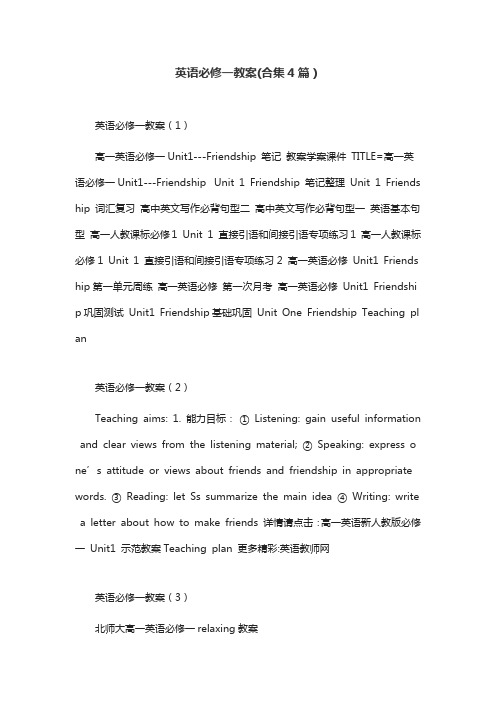
英语必修一教案(合集4篇)英语必修一教案(1)高一英语必修一Unit1---Friendship 笔记教案学案课件TITLE=高一英语必修一Unit1---Friendship Unit 1 Friendship 笔记整理Unit 1 Friends hip 词汇复习高中英文写作必背句型二高中英文写作必背句型一英语基本句型高一人教课标必修1 Unit 1 直接引语和间接引语专项练习1 高一人教课标必修1 Unit 1 直接引语和间接引语专项练习2 高一英语必修Unit1 Friends hip第一单元周练高一英语必修第一次月考高一英语必修Unit1 Friendshi p巩固测试Unit1 Friendship基础巩固Unit One Friendship Teaching pl an英语必修一教案(2)Teaching aims: 1. 能力目标:①Listening: gain useful information and clear views from the listening material; ②Speaking: express o ne’s attitude or views about friends and friendship in appropriate words. ③Reading: let Ss summarize the main idea ④Writing: write a letter about how to make friends 详情请点击:高一英语新人教版必修一Unit1 示范教案Teaching plan 更多精彩:英语教师网英语必修一教案(3)北师大高一英语必修一relaxing教案导语:编写教案要依据教学大纲和教科书。
从学生实际情况出发,精心设计。
以下是北师大高一英语必修一relaxing教案,供各位阅读和参考。
学习目标Students are to be able topredict what to hear.use the group of words related to stress.tell the ways to deal with the stress.教学流程学生背景升入高中后的第二节英语课。
高中英语必修一教学设计unit1
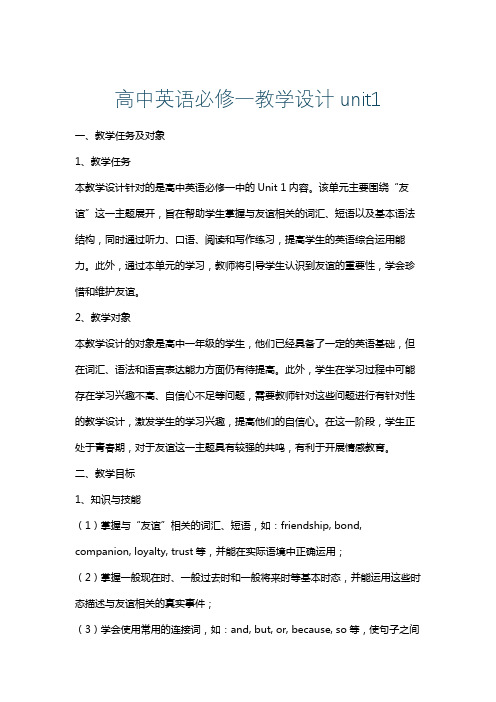
高中英语必修一教学设计unit1一、教学任务及对象1、教学任务本教学设计针对的是高中英语必修一中的Unit 1内容。
该单元主要围绕“友谊”这一主题展开,旨在帮助学生掌握与友谊相关的词汇、短语以及基本语法结构,同时通过听力、口语、阅读和写作练习,提高学生的英语综合运用能力。
此外,通过本单元的学习,教师将引导学生认识到友谊的重要性,学会珍惜和维护友谊。
2、教学对象本教学设计的对象是高中一年级的学生,他们已经具备了一定的英语基础,但在词汇、语法和语言表达能力方面仍有待提高。
此外,学生在学习过程中可能存在学习兴趣不高、自信心不足等问题,需要教师针对这些问题进行有针对性的教学设计,激发学生的学习兴趣,提高他们的自信心。
在这一阶段,学生正处于青春期,对于友谊这一主题具有较强的共鸣,有利于开展情感教育。
二、教学目标1、知识与技能(1)掌握与“友谊”相关的词汇、短语,如:friendship, bond, companion, loyalty, trust等,并能在实际语境中正确运用;(2)掌握一般现在时、一般过去时和一般将来时等基本时态,并能运用这些时态描述与友谊相关的真实事件;(3)学会使用常用的连接词,如:and, but, or, because, so等,使句子之间逻辑清晰,表达连贯;(4)提高英语听力水平,能听懂并理解关于友谊的对话、短文等;(5)提高英语口语表达能力,能就友谊主题进行讨论、发表观点和进行情景对话;(6)提高英语阅读理解能力,通过阅读相关文章,把握文章主旨和作者观点;(7)提高英语写作能力,能就友谊主题撰写短文,表达自己的观点和感受。
2、过程与方法(1)通过小组合作、讨论、分享等方式,让学生在实践中掌握英语知识与技能;(2)运用任务型教学法,设计各种与友谊相关的真实情境,引导学生运用所学知识解决问题;(3)采用启发式教学,激发学生的思维和创造力,培养他们独立思考和解决问题的能力;(4)利用多媒体教学资源,如音频、视频、图片等,丰富教学手段,提高学生的学习兴趣;(5)注重个性化教学,关注学生的个体差异,针对性地进行辅导,使每个学生都能在原有基础上得到提高。
高中英语必修1教案
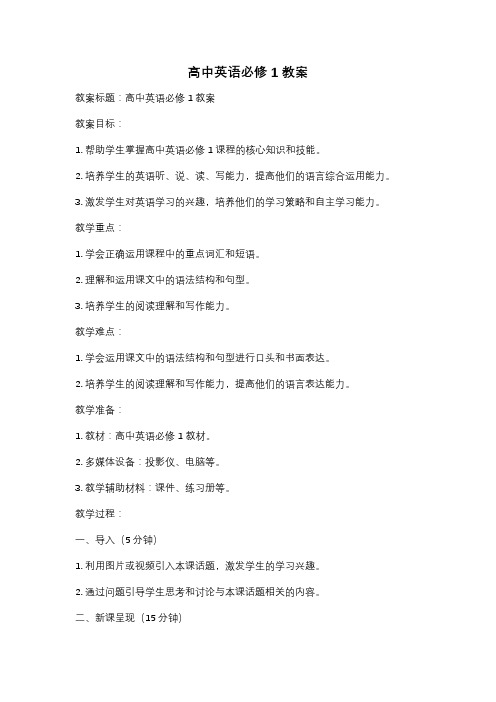
高中英语必修1教案教案标题:高中英语必修1教案教案目标:1. 帮助学生掌握高中英语必修1课程的核心知识和技能。
2. 培养学生的英语听、说、读、写能力,提高他们的语言综合运用能力。
3. 激发学生对英语学习的兴趣,培养他们的学习策略和自主学习能力。
教学重点:1. 学会正确运用课程中的重点词汇和短语。
2. 理解和运用课文中的语法结构和句型。
3. 培养学生的阅读理解和写作能力。
教学难点:1. 学会运用课文中的语法结构和句型进行口头和书面表达。
2. 培养学生的阅读理解和写作能力,提高他们的语言表达能力。
教学准备:1. 教材:高中英语必修1教材。
2. 多媒体设备:投影仪、电脑等。
3. 教学辅助材料:课件、练习册等。
教学过程:一、导入(5分钟)1. 利用图片或视频引入本课话题,激发学生的学习兴趣。
2. 通过问题引导学生思考和讨论与本课话题相关的内容。
二、新课呈现(15分钟)1. 利用多媒体设备展示课文,帮助学生理解课文内容。
2. 讲解课文中的重点词汇和短语,并进行词义和用法讲解。
3. 介绍课文中的语法结构和句型,并进行语法解析和练习。
三、讲解与练习(20分钟)1. 分组或个人练习,运用课文中的语法结构和句型进行口头表达。
2. 配发练习册,让学生完成相关的练习题,巩固所学知识。
3. 针对学生可能存在的问题进行解答和指导。
四、拓展与运用(15分钟)1. 利用课堂活动或小组讨论,引导学生运用所学知识进行实际情境的交流。
2. 设计相关的写作任务,让学生运用所学知识进行写作练习。
3. 对学生的表达进行评价和指导,帮助他们提高语言表达能力。
五、总结与反思(5分钟)1. 对本节课的重点内容进行总结和回顾。
2. 鼓励学生对自己的学习进行反思,提出问题和建议。
3. 预告下节课的内容,激发学生的学习兴趣。
教学延伸:1. 布置相关的课后作业,巩固学生的学习成果。
2. 提供相关的学习资源和参考资料,鼓励学生进行自主学习。
3. 鼓励学生参加英语角、英语竞赛等活动,提高他们的语言实际运用能力。
最新上海教育出版社高一英语必修一教案
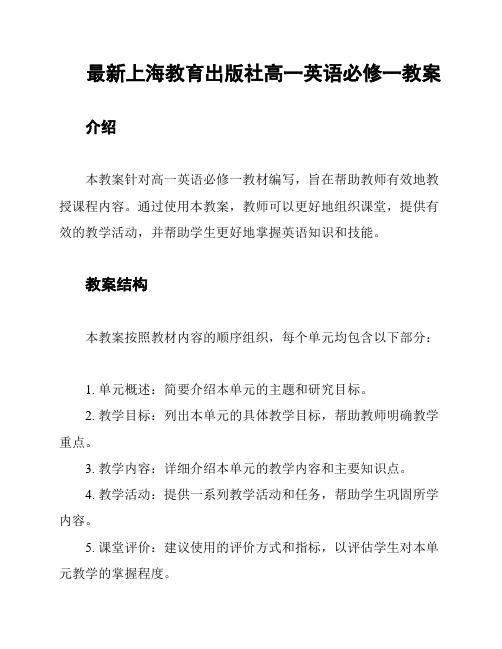
最新上海教育出版社高一英语必修一教案介绍本教案针对高一英语必修一教材编写,旨在帮助教师有效地教授课程内容。
通过使用本教案,教师可以更好地组织课堂,提供有效的教学活动,并帮助学生更好地掌握英语知识和技能。
教案结构本教案按照教材内容的顺序组织,每个单元均包含以下部分:1. 单元概述:简要介绍本单元的主题和研究目标。
2. 教学目标:列出本单元的具体教学目标,帮助教师明确教学重点。
3. 教学内容:详细介绍本单元的教学内容和主要知识点。
4. 教学活动:提供一系列教学活动和任务,帮助学生巩固所学内容。
5. 课堂评价:建议使用的评价方式和指标,以评估学生对本单元教学的掌握程度。
6. 扩展活动:提供一些拓展活动的建议,帮助学生深入研究和实践英语知识。
使用方法教师可以根据自己的教学需求,选择合适的教学活动和评价方式进行教学。
本教案提供了多样的教学活动,可以根据学生的实际情况进行调整和适应。
教师在使用本教案时,应结合课堂实际情况和学生的研究能力,合理安排教学进度和内容。
同时,教师还可以根据学生的研究效果和反馈情况,对教学活动和评价方式进行适当调整和改进。
注意事项1. 教师在使用本教案时,应遵循相关的教学要求和指南。
2. 本教案仅供参考,请教师根据实际情况进行调整和改进。
3. 教师在使用本教案时,应根据学生的实际情况进行差异化教学。
4. 本教案中的教学活动和评价方式仅供参考,教师可以根据需要进行适当调整和改进。
结束语本教案旨在帮助教师更好地开展高一英语必修一的教学工作。
通过合理使用教案中的教学活动和评价方式,教师可以提高教学效果,帮助学生更好地掌握英语知识和技能。
教师应根据学生的实际情况和教学需求,灵活运用本教案,使课堂教学更加生动有趣,达到预期的教学效果。
2023最新-高一英语必修一教案(精选5篇)

高一英语必修一教案(精选5篇)时间过得太快,让人猝不及防,成绩已属于过去,新一轮的工作即将来临,现在的你想必不是在做计划,就是在准备做计划吧。
什么样的计划才是有效的呢?这次漂亮的小编为亲带来了5篇高一英语必修一教案,我们不妨阅读一下,看看是否能有一点抛砖引玉的作用。
高一英语必修一教案篇一高一英语对于学生来说具有承上启下的关键作用,以下是“高一英语必修课件”希望能够帮助的到您!高一英语必修一知识:动词-ing形式作主语1. 动词-ing形式作主语时,主要有三种形式。
(1)动词-ing直接置于句首主语的位置上Playing tricks on others is something we should never do.捉弄别人是我们万万不能干的。
Saying is easier than doing.说起来容易做起来难。
(2)用it作形式主语,而把真正的主语移置句尾,以保持句子平衡。
常见句型有:It is / was a waste of time / money doing ….做……是浪费时间或金钱It is / was useless / no use / no good doing …做……是无用/无益的It is/was worth/worthwhile doing …做……是值得的It is no use crying over spilt milk. 覆水难收。
It’s worth making the effort. 这事值得去做。
It’s a waste of time arguing about it. 争辩此事是在浪费时间。
(3) 在there is no 结构中通常用动词-ing形式作主语常见的句型有:There is/was no doing… 无法在……;不允许……There is/was no sense (in) doing… 做……没有道理/意义There is/was no use/ point (in ) doing… 干……无意义There is no joking about such matter.这种事开不得玩笑。
高一必修一英语教案(精选4篇)

高一必修一英语教案(精选4篇)高一必修一英语教案(精选4篇)教案中对每个课题或每个课时的教学内容,教学步骤的安排,教学方法的选择,板书设计,教具或现代化教学手段的应用,各个教学步骤教学环节的时间分配等等,下面是为大家整理的关于高一必修一英语教案,欢迎大家阅读参考学习!高一必修一英语教案精选篇1一、教材分析(一)教材的地位和作用本节课是本单元以及本教材的第一节课,本课谈论的是:朋友是不是仅限于人类、朋友的真正含义、如何与人相处的问题等关于朋友的话题。
本课涉及的有陈述句和疑问句的直接引语和间接引语的掌握和运用等语法要点。
学生从初中到高中,来到一个新的学校,同学彼此陌生,不免想起老同学,老朋友。
这样的话题正好能引起学生的兴趣。
而且本课的内容和语法的启发性和实用性都很强,能使学生在学中用,在用中学,对综合提高学生的听说读写能力有较好的促进作用。
(二)教学目标英语教学大纲规定,通过听说读写的训练,使学生获得英语基础知识和运用英语的能力,激发学生的学习兴趣,为进一步学习打下良好的基础。
因此,我制定以下教学目标:知识目标:1、掌握和使用陈述句和疑问句的直接引语和间接引语。
2、讨论朋友和友谊。
3、学习掌握本课的重点词汇。
技能目标:1、学会阅读的技能——scanningand skimming 。
2、通过谈论朋友和友谊,既锻炼学生的语言运用能力,又培养了学生发现问题、思考问题、解决问题的能力。
3、理解阅读文段,复述故事。
情感态度:1、患难之交才是真朋友。
2、知音难得。
3、海内存知己,天涯若比邻。
文化意识:认识德国纳粹党。
让学生了解那段德国法西斯残害犹太人的历史,使学生在感受外国历史文化的同时自然而然的习得语言。
(三)重点与难点重点:1、训练scanningand skimming等阅读技能。
2、认识朋友的真正含义以及与人相处的问题。
难点:1、阅读技能的训练。
2、陈述句和疑问句的直接引语和间接引语的互相转换(人称的变化、时态的变化、指示代词、时间状语、地点状语和动词的变化)。
高中英语必修一教案设计模板(共20篇)

高中英语必修一教案设计模板(共20篇)第1篇:高中英语必修一第一单元教案Unit 1 Friendship I.Warming Up 1.good: adj.好心的,仁慈的,乐于助人的 be good to sb.: 对某人好e.g.She’s good to me.I am good to my friends.be good to do sth.: 仁慈的,乐于助人的e.g.Would you be good enough to carry this for me?good的固定搭配:①be good at sth.: 擅长做某事 e.g.Tom is good at swimming.I am not good at English.②be good for sb./sth.: 有益于某人/某事e.g.Is this kind of food good for us?Sunshine is good for your plants.③be g ood for sth.: 适合干某事、适宜于某事 e.g.She would be good for the job.This beach is good for swimming but bad for surfing.→be bad for:a.对……无益处 b.不适于……2.add up: 把……全加在一起e.g.Add up all these figures and you will know the result.add 的固定搭配add to: 加,增加,添加e.g.Fireworks added to the attraction of the festival night.add sth to: 把某物添加到…… e.g.She added some salt to the soup.Please add some sugar to the coffee.add up to: 合计是……e.g.All the money adds up to 1000 dollars.3.get sth.+ 过去分词e.g.You’d better get the car repaired.Do you know how to get it colored?4.upset: adj.不安的,心烦意乱的e.g.I was very upset becauseI failed the exam.vt.使心烦意乱,使不安e.g.His rude behaviors upset her.Don’t up set yourself.5.be concerned about: 为……担心;关心,关注e.g.We are all concerned about her safety.I’m very concerned about his attitude to my work.concerned: adj.关心的,担心的,忧虑的 concern: v.对……有关系,影响e.g.This concerns the healthy growth of the children.Pay attention to what concerns you.6.should have done: 本应该做某事(虚拟语气,意指过去应该做的事情,却没有做,含有遗憾、职责等意味)e.g.You should have told me the news earlier.We should have stopped him.I should have thought of that.→shouldn’t have done: 本不应该做(指过去不应该做的事情,却做了)e.g.He shouldn’t have come at all.You shouldn’t have told her the news.第2篇:高中英语必修一unit1教学设计高一英语必修一教案:Unit11.能力目标:a.Listening: get information and views from the listening material;b.Speaking: expre one’s attitude or views about friends and friendship in appropriate words.c.Reading: enable the Ss to get the main idead.Writing: write some advice about making friend as an editor2.知识目标:a.Talk about friends and friendship;how to make friends;how to maintain friendshipe the following expreions:I think so./ I don’t think so.I agree./ I don’t agree.That’s correct.Of course not.Exactly.I’m afraid not.c.to enable the Ss to control direct speech and indirect speechd.vocabulary: add point upset calm concern carele loose cheat reason list share feeling thought German series outdoors crazy moonlight purpose dare thunder entirely power according trust indoors suffer teenager advice quiz editor communicate situation habitadd up calm down have got to be concerned about walk the dog go through hide away set down a series of on purpose in order to face to face according to get along with fall in love join in3.情感目标:a.To arose Ss’ interes t in learning English;b.To encourage Ss to be active in the activities and make Ss to be confident;c.To develop the ability to cooperate with others.4.策略目标:a.To develop Ss’ cognitive strategy: taking notes while listening;b.To develop Ss’ communicative strategies.5.文化目标:to enable the Ss to get to know different opinions about making friends from different countries.Teaching steps:step1.lead-in1.let students talk about their summer holidays and their feelings.then get them to talk about friends, such as old friends in junior middle school, about their appearance, personality, hobbies, etc.poible questions:(1)how did you spend your summer holidays? how did you feel?(2)what do you think of our new school? do you like it? could you say something about it?(3)do you like making friends? how many good friends do you have? what are they like? step 2.brainstorming(1)what qualities do you think a good friend should have?honest, loyal, friendly, brave, humorous, funny, wise, kind(2)what proverbs do you know about friends and friendship?eg: a friend in need is a friend indeed.friends are just the people who share your happine and sorrow.to have a friend, you need to be a good friend.a life without a friend is a life without the sun.a man who has friends must show himself friendly.step3.pre-reading1.why do you need friends?2.do you think a diary can become your friend? why or why not?3.what do you know about world war ⅱ?(show pictures about world war ⅱ on ppt)let students answer the above questions and give them some background information about the author anne frank, and show them some pictures of her.step4.fast readinglet students skim the text and answer these questions.1.who was anne’s best friend? 2.why did she make friends with it?3.when did the story happen? step5.careful reading 1.listening to the tape with 3 questions:(1)what did she do?(2)why did she do that way?(3)how did she enjoy herself? 2.summarize the main idea for each paragraph in one sentence.(students may discu it in pairs and they are supposed to produce a concise answer.)3.do exercise 2 on page 3.step 6.post-reading discuion: 1.divide the whole cla into 8 groups and elect a group leader of each group.(1)why did anne write such a diary?(2)what's anne's tone? in other words, is she angry, sad, happy or frightened ?(3)thestructure of this paage: narrative writing.what phrases or sentences are used to describe a situation ,a problem ,or a person or a place ? 2.talking about friends and friendship(1).there are many proverbs about friends and friendship.choose the one you agree with and explain why, then choose one you disagree with and explain why.a friend in need is a friend indeed.friends are like wine;the older, the better.a friend to all is a friend to none.false friends are worse than open enemies.walking with a friend in the dark is better than walking alone in the light.(2).we have talked about friends and friendship today, can you write one or two sentences to expre your understanding of friends and friendship.step 7.homework e the internet to find out more about some background knowledge of world war and anne’diary.2.write a diary about something you met.第3篇:高中英语必修一unit3 教学设计必修一第三单元 Travel Journal一、教学内容介绍该课是根据高一英语新教材第一模块第三单元Travel Journal中课后学生用书中的Writing Task扩展而成的一节活动课,是新课程教学实践中一次较为大胆的尝试。
高中英语必修一教案
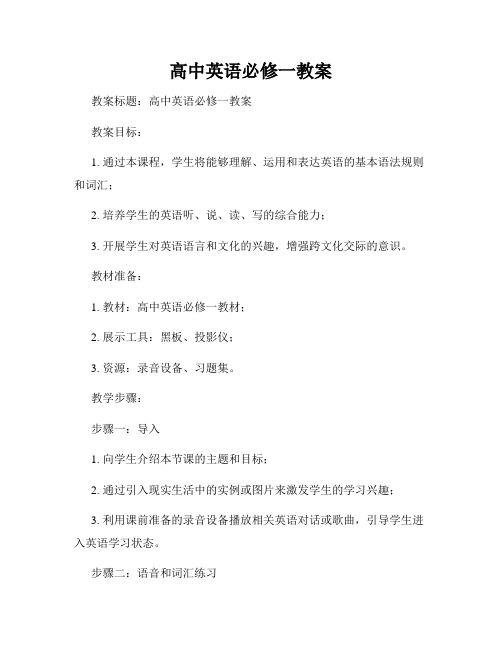
高中英语必修一教案教案标题:高中英语必修一教案教案目标:1. 通过本课程,学生将能够理解、运用和表达英语的基本语法规则和词汇;2. 培养学生的英语听、说、读、写的综合能力;3. 开展学生对英语语言和文化的兴趣,增强跨文化交际的意识。
教材准备:1. 教材:高中英语必修一教材;2. 展示工具:黑板、投影仪;3. 资源:录音设备、习题集。
教学步骤:步骤一:导入1. 向学生介绍本节课的主题和目标;2. 通过引入现实生活中的实例或图片来激发学生的学习兴趣;3. 利用课前准备的录音设备播放相关英语对话或歌曲,引导学生进入英语学习状态。
步骤二:语音和词汇练习1. 在黑板上呈现相关语音和词汇的拼写和发音规则;2. 通过单词卡片、图片、或表格等形式展示相关词汇;3. 要求学生跟读、模仿,进行语音和词汇的练习;4. 利用习题集或教材中相关练习,加深学生对语音和词汇的理解和掌握。
步骤三:听力和口语训练1. 播放与本节课主题相关的听力素材,要求学生仔细聆听并回答问题;2. 结合听力材料,教授相关的口语表达方式和实用句型;3. 引导学生进行口语对话练习,例如,分组对话或角色扮演。
步骤四:阅读和写作练习1. 展示本节课的阅读材料,并对重点词汇和句子进行解释;2. 要求学生阅读材料,并回答相关问题,提高阅读理解能力;3. 引导学生进行写作练习,例如,要求学生写一篇关于本节课主题的短文或进行写作讨论。
步骤五:课堂总结和评价1. 整理本节课的重点内容,进行小结;2. 进行课堂评价,可以通过口头提问或书面测试的形式;3. 对学生关于本节课的问题进行解答和指导。
步骤六:作业布置1. 布置与本节课内容相关的课后作业;2. 提供相关参考资料和习题集,以便学生进行自主学习。
注意事项:1. 在教学过程中要注意与学生互动,鼓励学生积极参与;2. 适当运用多媒体技术,如投影仪、录音设备等,提高教学效果;3. 引导学生在课后进行复习和巩固,并定期进行测试和评估,及时发现和解决问题。
新课标高一英语必修一全册教案
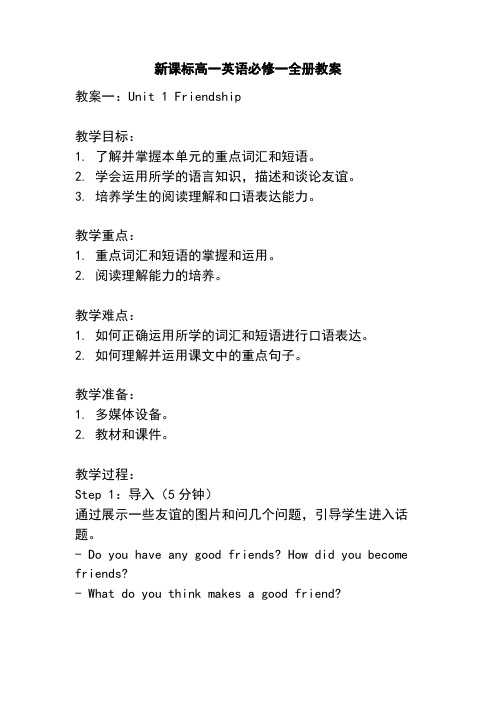
新课标高一英语必修一全册教案教案一:Unit 1 Friendship教学目标:1. 了解并掌握本单元的重点词汇和短语。
2. 学会运用所学的语言知识,描述和谈论友谊。
3. 培养学生的阅读理解和口语表达能力。
教学重点:1. 重点词汇和短语的掌握和运用。
2. 阅读理解能力的培养。
教学难点:1. 如何正确运用所学的词汇和短语进行口语表达。
2. 如何理解并运用课文中的重点句子。
教学准备:1. 多媒体设备。
2. 教材和课件。
教学过程:Step 1:导入(5分钟)通过展示一些友谊的图片和问几个问题,引导学生进入话题。
- Do you have any good friends? How did you become friends?- What do you think makes a good friend?Step 2:词汇和短语学习(10分钟)通过多媒体展示和示范,教授本单元的重点词汇和短语。
- friendship, loyal, trust, support, companion, betray, argue, forgive, appreciate, value, make friends, keep in touch, get along with, fall out with, make upStep 3:阅读理解(20分钟)教师通过多媒体展示,让学生阅读课文,并进行理解。
- 学生阅读课文,并回答一些问题,如:What is the main idea of the passage? What does the author think about friendship? How does the author describe a good friend?Step 4:语言运用(15分钟)通过讨论和练习,让学生运用所学的语言知识进行口语表达。
- 讨论题目:What qualities do you think a good friend should have? Give examples to support your ideas.- 练习:学生分组进行角色扮演,模拟对话中的情景。
有关高一英语必修一教案5篇

有关高一英语必修一教案5篇有关高一英语必修一教案5篇在写一篇教案的时候,需要每个月、每一周、每一天的合理安排和具体实施。
下面是小编为你准备的高一英语必修一教案,快来借鉴一下并自己写一篇与我们分享吧!高一英语必修一教案(精选篇1)教学目标1、知识目标:1)Students should learn some useful words and phrases: musician, clap, passer-by, form, extra, earn, advertisement, 2 attractive, instrument, loosely, actor dream of, be honest with, play jokes on, or so, break up. 3)Students should understand the general idea of the passage2、语言能力目标:1)Develop the Ss’skills of skimming, scanning and careful reading. 2) Train the Ss to find the key words and the topic sentences. 3)Encourage the Ssto guess the new words according the reading.3、情感态度与文化意识目标:1)Encourage the Ss to share the different kinds of music. 2)Improve the cooperation and share among the students.教学重难点1、教学重点:a.To understudend the passage better b.To find the main idea of each paragraph2、教学难点:a.Master the reading ability b.Develop the skills of reading教学过程教学设计本节课共45分钟,具体教学步骤如下:Step I Leading-in播放一段小视频,内容为歌曲If you are happy的英文版本,通过介绍演唱乐队twins引出本单元话题。
高一英语必修1教案
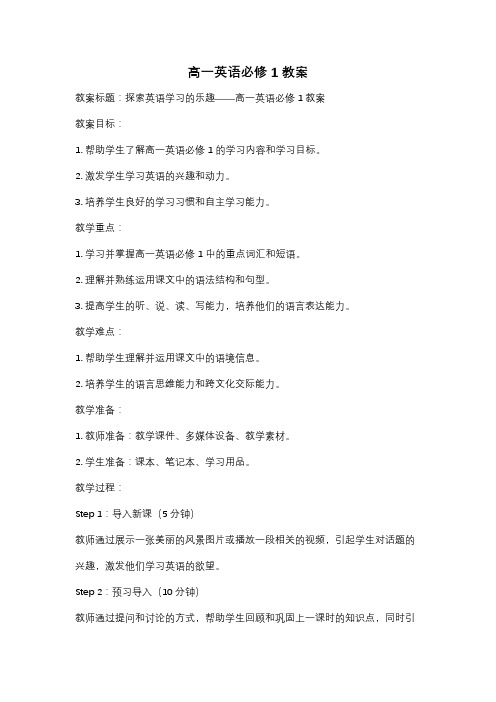
高一英语必修1教案教案标题:探索英语学习的乐趣——高一英语必修1教案教案目标:1. 帮助学生了解高一英语必修1的学习内容和学习目标。
2. 激发学生学习英语的兴趣和动力。
3. 培养学生良好的学习习惯和自主学习能力。
教学重点:1. 学习并掌握高一英语必修1中的重点词汇和短语。
2. 理解并熟练运用课文中的语法结构和句型。
3. 提高学生的听、说、读、写能力,培养他们的语言表达能力。
教学难点:1. 帮助学生理解并运用课文中的语境信息。
2. 培养学生的语言思维能力和跨文化交际能力。
教学准备:1. 教师准备:教学课件、多媒体设备、教学素材。
2. 学生准备:课本、笔记本、学习用品。
教学过程:Step 1:导入新课(5分钟)教师通过展示一张美丽的风景图片或播放一段相关的视频,引起学生对话题的兴趣,激发他们学习英语的欲望。
Step 2:预习导入(10分钟)教师通过提问和讨论的方式,帮助学生回顾和巩固上一课时的知识点,同时引导学生预测本课时的学习内容。
Step 3:新课呈现(15分钟)教师通过多媒体展示课文的主要内容,引导学生跟读并理解课文。
同时,教师注重讲解课文中的重点词汇、短语和语法结构,并通过实例演示和练习巩固学生的理解和运用能力。
Step 4:合作学习(20分钟)教师组织学生进行小组讨论和合作学习,让学生在小组内互相激励和帮助,共同解决问题和完成任务。
教师可以设计一些情景对话、角色扮演或小组竞赛等活动,激发学生的参与和合作意识。
Step 5:个人巩固(10分钟)教师布置一些个人巩固练习,如填空、改错、翻译等,让学生独立完成,检验他们对所学知识的掌握程度。
Step 6:课堂总结(5分钟)教师对本节课的学习内容进行总结,并提醒学生复习和预习下一节课的内容。
Step 7:作业布置(5分钟)教师布置适量的课后作业,如课文朗读、词汇记忆、语法练习等,巩固学生的学习成果。
教学延伸:1. 鼓励学生参加英语角、英语竞赛等活动,提高他们的英语口语表达能力。
- 1、下载文档前请自行甄别文档内容的完整性,平台不提供额外的编辑、内容补充、找答案等附加服务。
- 2、"仅部分预览"的文档,不可在线预览部分如存在完整性等问题,可反馈申请退款(可完整预览的文档不适用该条件!)。
- 3、如文档侵犯您的权益,请联系客服反馈,我们会尽快为您处理(人工客服工作时间:9:00-18:30)。
教科版高中英语必修一备课教案/教学设计
Unit 1 TEACHERS' DAY
【教学目标】
1.知识目标
(1)重点词汇和短语:foremost, ancient, according to, class, require, respect, government, policy, receive, illiterate, citizen, provincial.
(2)能理解、应用句型:
a.There will be a meeting tomorrow.
b.Confucius gave us a good example.
c.Confucius had more than three thousand students.
d.Confucius has always been a model for all teachers.
2.语言技能目标
(1)理解并掌握新词的及应用。
(2)理解材料内容:通过上下文克服生词困难,掌握听力技巧,提高英语听力能力。
3.情感态度、文化意识、学习策略
在“学生为主体”的思想指导下,让学生成为课堂的主人,形成有效的“生生互动”、“和谐对话”,同时借助多媒体的优势使学生主动融入课堂教学情境之中,以调动学生积极性,激发学生参与课堂的潜能,建立良好的课堂氛围,真正发挥情感教学的优势。
第 1 页共32 页。
